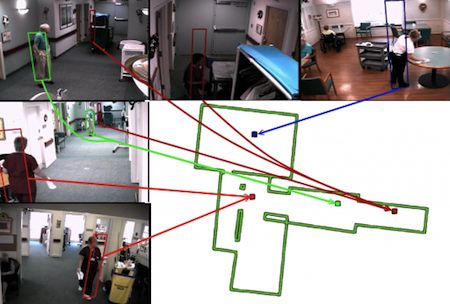Science Fiction
Dictionary
A B C D E F G H I J K L M N O P Q R S T U V W X Y Z
'Marauder's Map' Created By Carnegie Melllon

It appears that Carnegie Mellon computer scientists and other researchers have created a way to track the locations of multiple individuals in a complex, indoor setting in real time. What does this remind you of?

(Tracking individuals in a nursing home)
The method was able to automatically follow the movements of 13 people within a nursing home, even though individuals sometimes slipped out of view of the cameras. None of Potter's magic was needed to track them for prolonged periods; rather, the researchers made use of multiple cues from the video feed: apparel color, person detection, trajectory and, perhaps most significantly, facial recognition.Multi-camera, multi-object tracking has been an active field of research for a decade, but automated techniques have only focused on well-controlled lab environments. The Carnegie Mellon team, by contrast, proved their technique with actual residents and employees in a nursing facility—with camera views compromised by long hallways, doorways, people mingling in the hallways, variations in lighting and too few cameras to provide comprehensive, overlapping views.
The performance of the Carnegie Mellon algorithm significantly improved on two of the leading algorithms in multi-camera, multi-object tracking. It located individuals within one meter of their actual position 88 percent of the time, compared with 35 percent and 56 percent for the other algorithms.
Usually, I restrict myself to science-fictional creations when writing articles for Technovelgy, but I hope readers will forgive me for noting that this technical accomplishment is a "Marauder's Map" brought to life from the pages of J.K. Rowling's Harry Potter books.
From Carnegie Mellon.
Scroll down for more stories in the same category. (Story submitted 6/17/2013)
Follow this kind of news @Technovelgy.| Email | RSS | Blog It | Stumble | del.icio.us | Digg | Reddit |
Would
you like to contribute a story tip?
It's easy:
Get the URL of the story, and the related sf author, and add
it here.
Comment/Join discussion ( 3 )
Related News Stories - (" Surveillance ")
LingYuan Vehicle Roof Drones Now Available, ala Blade Runner 2049
Accompanied by a small selection of similar ideas from science fiction.
Chameleon Personalized Privacy Protection Mask
'...the Virtual Epiphantic Identity Lustre.' - Neal Stephenson, 2019.
Spherical Police Robot Rolls In China
'Rand could effectively be in several places at once...' - Niven and Pournelle, 1981.
Vietnam To Have Full Biometric Transparency
'inscriptions too small to be seen with the naked eye; microscopic data...' - Eric Frank Russell, 1939.
Technovelgy (that's tech-novel-gee!) is devoted to the creative science inventions and ideas of sf authors. Look for the Invention Category that interests you, the Glossary, the Invention Timeline, or see what's New.
Science Fiction
Timeline
1600-1899
1900-1939
1940's 1950's
1960's 1970's
1980's 1990's
2000's 2010's
Current News
Replace The Smartphone With A Connected Edge Node For AI Inference
'Buy a Little Dingbat... electropen, wrist watch, pocketphone, pocket radio, billfold ... all in one.'
Artificial Skin For Robots Is Coming Right Along
'... an elastic, tinted material that had all the feel and appearance of human flesh and epidermis.'
Robot Guard Dog On Duty
I might also be thinking of K-9 from Doctor Who.
Wearable Artificial Fabric Muscles
'It is remarkable that the long leverages of their machines are in most cases actuated by a sort of sham musculature...'
BrainBridge Concept Transplant Of Human Head Proposed
'Briquet’s head seemed to think that to find and attach a new body to her head was as easy as to fit and sew a new dress.'
Google's Nano Banana Pro Presents Handwritten Math Solutions
'...copy was turned out in a charming and entirely feminine handwriting.'
Edible Meat-Like Fungus Like Barbara Hambly's Slunch?
'It was almost unheard of for slunch to spread that fast...'
Sunday Robotics 'Memo' Bot Has Unique Training Glove
'He then started hand movements of definite pattern...'
Woman Marries Computer, Vonnegut's Dream Comes True
'Men are made of protoplasm... Lasts forever.'
Natural Gait With Prosthetic Connected To Nervous System
'The leg was to function, in a way, as a servo-mechanism operated by Larry’s brain...'
Spidery 'Walk Me' Toyota Autonomous Wheel Chair Like Star Wars
Walk along with the emperor.
Dancing Robots Taught Dance Moves
'A clockwork figure would be the thing for you...'
Proof Of Robothood - Not A Person
'Who are you people? - Show 'em.'
Indonesian Clans Battle
'The observation vehicle was of that peculiar variety used in conveying a large number of people across rough terrain.'
The 'Last Mile' In China Crowded With Delivery Robots
Yes, it's a delivery robot. On wheels.
Tornyol Microdrone Kills Mosquitoes
'The real border was defended by... a swarm of quasi-independent aerostats.'
